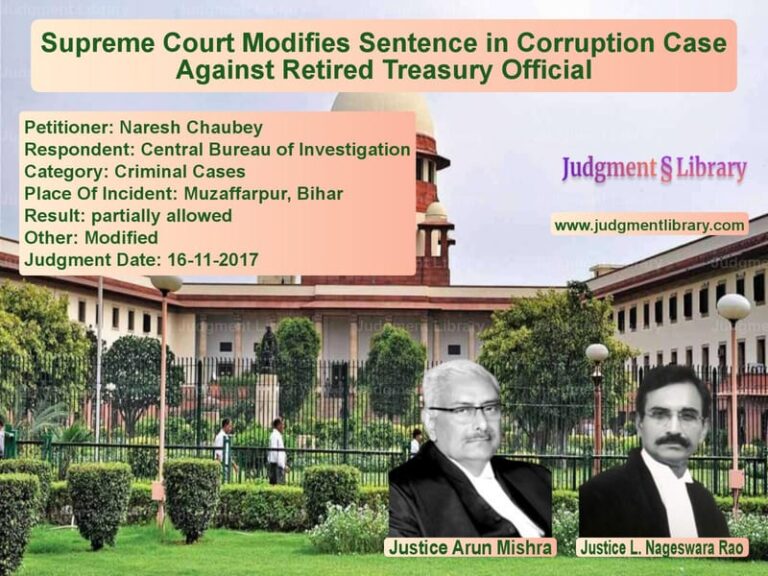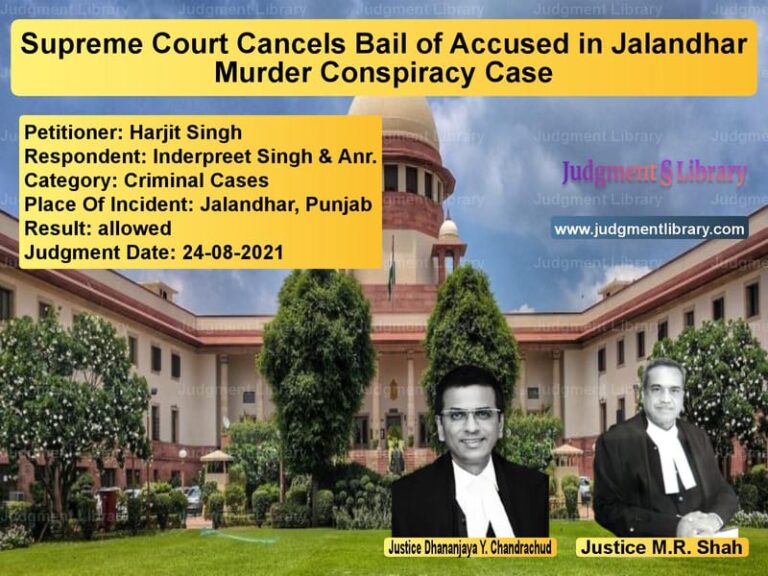Dying Declaration in Criminal Cases: Supreme Court Acquits Man Convicted for Wife’s Death
The Supreme Court of India recently delivered a significant judgment in Suresh v. State Rep. By Inspector of Police, where it overturned the conviction of the appellant, Suresh, who had been sentenced to life imprisonment under Section 302 of the Indian Penal Code (IPC) for the alleged murder of his wife. The case revolved around conflicting dying declarations made by the deceased and a lack of corroborative evidence supporting the prosecution’s case.
Background of the Case
The incident occurred on September 12, 2008, in Tuticorin, Tamil Nadu, where the appellant, his wife (the deceased), and their 2.5-year-old child lived. On the fateful evening, the deceased suffered severe burn injuries and was taken to multiple hospitals before being admitted to a government hospital, where she succumbed to her injuries on October 2, 2008. Initially, she stated that the fire was accidental, but in a later dying declaration, she accused her husband of setting her on fire.
Chronology of Events
- September 12, 2008 (Day of Incident): The deceased suffered burns and was admitted to the hospital. She gave a statement to the police (PW-9) and the attending doctor (PW-13), stating that she caught fire while cooking.
- September 15, 2008: The police initially registered the case as an accidental fire but later modified it to an offense under Section 307 IPC (Attempt to Murder) after the deceased allegedly changed her statement.
- September 18, 2008: The Judicial Magistrate (PW-12) recorded a dying declaration in which the deceased accused her husband of setting her on fire.
- October 2, 2008: The deceased succumbed to her burn injuries, leading to the alteration of charges from Section 307 IPC to Section 302 IPC (Murder).
- February 28, 2012: The Madras High Court upheld the trial court’s conviction, sentencing Suresh to life imprisonment.
- March 4, 2025: The Supreme Court overturned the conviction and acquitted the appellant.
Arguments by the Parties
Petitioner’s (Appellant’s) Arguments
- The first two statements of the deceased, made on September 12, 2008, were consistent in stating that the fire was accidental.
- The dying declaration recorded on September 18, 2008, was unreliable as it contradicted the earlier statements and lacked corroborative evidence.
- Key witnesses, including the deceased’s mother (PW-1) and father (PW-2), provided contradictory statements regarding whether the appellant tried to save the deceased.
- The deceased’s body did not show any external injuries, indicating no physical assault before the burns.
- The prosecution failed to establish motive beyond a reasonable doubt.
Respondent’s (State’s) Arguments
- The Judicial Magistrate recorded a formal dying declaration in which the deceased explicitly named the appellant as the perpetrator.
- The prosecution relied on the presence of a kerosene can and matchsticks found at the crime scene.
- The testimony of PW-1 and PW-2 suggested that the appellant did not attempt to take the deceased to the hospital.
- The deceased’s delay in revealing the truth was allegedly due to fear of the appellant.
Supreme Court’s Analysis
Multiple Dying Declarations and Their Reliability
The Supreme Court emphasized that dying declarations can be relied upon as primary evidence, but their credibility must be carefully scrutinized, especially when multiple and inconsistent statements exist.
“In cases involving multiple dying declarations made by the deceased, the question that arises for consideration is as to which of the said dying declarations ought to be believed by the court and what would be the guiding factors for arriving at a just and lawful conclusion.”
The Court highlighted that the deceased initially made two consistent statements attributing the incident to an accident, which contradicted the later dying declaration accusing the appellant. The Court noted:
“The first statement was made to the doctor (PW-13) on the day of the incident, where she told him that she caught fire while cooking. The second statement, made to the police constable (PW-9), was identical.”
Lack of Corroborative Evidence
- The doctor (PW-13) testified that the deceased had no smell of kerosene when brought to the hospital, contradicting the claim that she was doused in kerosene.
- The prosecution’s Observation Mahazar (inspection report) was doubtful as witnesses to the seizure of the kerosene can (PW-5 and PW-6) turned hostile.
- The mother (PW-1) and father (PW-2) contradicted themselves regarding whether the appellant attempted to save his wife.
- The appellant, who suffered from 40% physical disability due to polio, was unlikely to have overpowered the deceased and set her ablaze.
Pre-Existing Family Disputes
The Court acknowledged a history of legal disputes between the appellant’s family and the deceased’s family. In 2006, the appellant’s brother had filed a case against the deceased’s father and brother, leading to their conviction. The Court considered whether this could have influenced the later dying declaration.
Final Verdict
Based on these findings, the Supreme Court ruled:
“For the reasons set out hereinabove, we allow the appeal and set aside the order of the High Court dated 28.02.2012. The appellant shall be released from jail forthwith.”
Key Takeaways from the Judgment
- Courts must scrutinize multiple dying declarations and assess their reliability based on surrounding evidence.
- A conviction cannot be based solely on an inconsistent dying declaration without corroborative evidence.
- The presence of pre-existing disputes between families must be considered when evaluating witness testimonies.
- Physical disabilities of an accused should be factored into the feasibility of committing the alleged crime.
Conclusion
This judgment serves as an important precedent for cases involving multiple dying declarations and underscores the need for corroborative evidence before convicting an accused. The Supreme Court’s decision reinforces the principle that an accused must be given the benefit of the doubt in cases of conflicting evidence.
Petitioner Name: Suresh.Respondent Name: State Rep. By Inspector of Police.Judgment By: Justice Sudhanshu Dhulia, Justice Ahsanuddin Amanullah.Place Of Incident: Tuticorin, Tamil Nadu.Judgment Date: 04-03-2025.
Don’t miss out on the full details! Download the complete judgment in PDF format below and gain valuable insights instantly!
Download Judgment: suresh-vs-state-rep.-by-inspec-supreme-court-of-india-judgment-dated-04-03-2025.pdf
Directly Download Judgment: Directly download this Judgment
See all petitions in Murder Cases
See all petitions in Bail and Anticipatory Bail
See all petitions in Judgment by Sudhanshu Dhulia
See all petitions in Judgment by Ahsanuddin Amanullah
See all petitions in allowed
See all petitions in supreme court of India judgments March 2025
See all petitions in 2025 judgments
See all posts in Criminal Cases Category
See all allowed petitions in Criminal Cases Category
See all Dismissed petitions in Criminal Cases Category
See all partially allowed petitions in Criminal Cases Category







